Four days under African skies
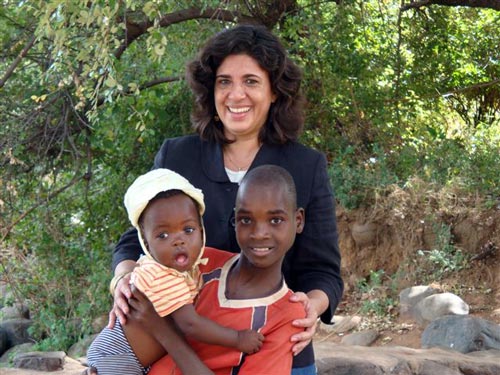 It was a short visit but by no means an unproductive one: from 18–22 May 2009, a Corporate Services team from CIMMYT-El Batán visited the center’s Nairobi and Harare regional offices. The team consisted of Luis De Anda, finance manager; Marisa de la O, human resources (HR) manager; Carlos López, information and communication technology (ICT) manager; and Scott Ferguson, deputy director general for Corporate Services.
It was a short visit but by no means an unproductive one: from 18–22 May 2009, a Corporate Services team from CIMMYT-El Batán visited the center’s Nairobi and Harare regional offices. The team consisted of Luis De Anda, finance manager; Marisa de la O, human resources (HR) manager; Carlos López, information and communication technology (ICT) manager; and Scott Ferguson, deputy director general for Corporate Services.
“By having direct interactions with our CIMMYT colleagues in Africa, we have a better idea of the issues they face with respect to Corporate Services,” said López. “We also gained a greater understanding of their local circumstances and challenges.”
Working as a team, the group was able to address workplace issues in their corresponding areas, and each also met with their local counterparts. López expressed the need for better communication across CIMMYT offices and for more internet tools and systems. While in Harare he worked with staff to ameliorate the office’s internet access which is via satellite, and said he was grateful for the opportunity to see CIMMYT’s mission firsthand.
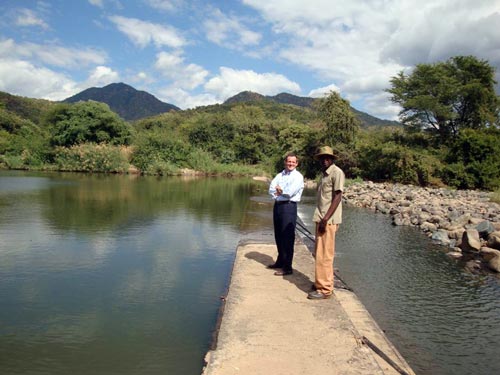 In Zimbabwe, the team visited the new dam that supplies water to CIMMYT’s Muzarabani station –the old dam was destroyed by flooding. Joseph Makamba, field supervisor, also showed them the station’s winter nursery, which had over seven hectares dedicated to nurseries and seed multiplication. Unfortunately, frequent power outages make nursery irrigation sporadic; during the visit Makamba had to travel 60 km to bring national power supply technicians to repair overhead power lines and restore electricity to the pumping station.
In Zimbabwe, the team visited the new dam that supplies water to CIMMYT’s Muzarabani station –the old dam was destroyed by flooding. Joseph Makamba, field supervisor, also showed them the station’s winter nursery, which had over seven hectares dedicated to nurseries and seed multiplication. Unfortunately, frequent power outages make nursery irrigation sporadic; during the visit Makamba had to travel 60 km to bring national power supply technicians to repair overhead power lines and restore electricity to the pumping station.
“I am impressed by the commitment, dedication, and ingenuity showed by the CIMMYT teams in Kenya and Zimbabwe,” said Ferguson, who also visited partner institutions with Mulugetta Mekuria, CIMMYT-Zimbabwe economist. While in Kenya, he urged staff to take the initiative and be creative in identifying solutions to problems and to share the solutions amongst themselves and with Corporate Services. “We will strive to streamline general administration and support services so that you can comfortably do what you do best,” he told staff.
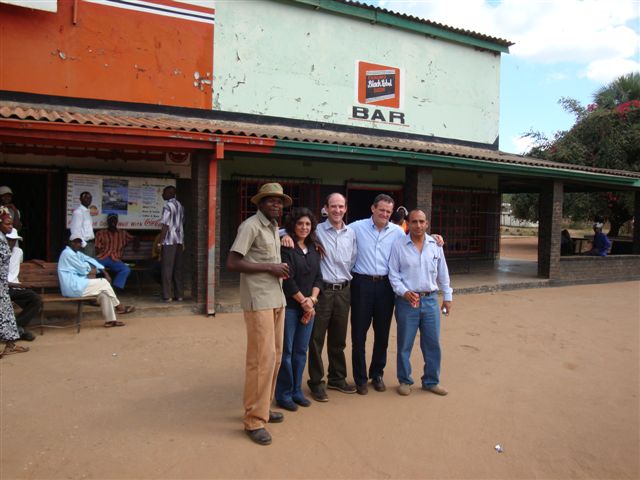 De la O was especially touched by the temporary workers she met in Harare, many of whom are mothers that leave their families for months at a time to make ends meet. “I would like for all employees to have the same level of benefits, regardless of where they’re from or if they are temporary or permanent,” she said. “We want to offer a better level of support and work in a global sense.” De la O addressed some issues on the spot, and will followup with others after an analysis of all the regional offices and making a strategic HR plan.
De la O was especially touched by the temporary workers she met in Harare, many of whom are mothers that leave their families for months at a time to make ends meet. “I would like for all employees to have the same level of benefits, regardless of where they’re from or if they are temporary or permanent,” she said. “We want to offer a better level of support and work in a global sense.” De la O addressed some issues on the spot, and will followup with others after an analysis of all the regional offices and making a strategic HR plan.
“I feel a huge commitment to the people I met,” she said. “It was a very moving, emotional experience and I’m excited and enthusiastic about continuing my work with CIMMYT.” De Anda expressed similar feelings, saying, “This experience helped me to understand what CIMMYT is behind the finances and numbers. We all know poverty exists in the world, but it’s different when you really see it with your own eyes.”
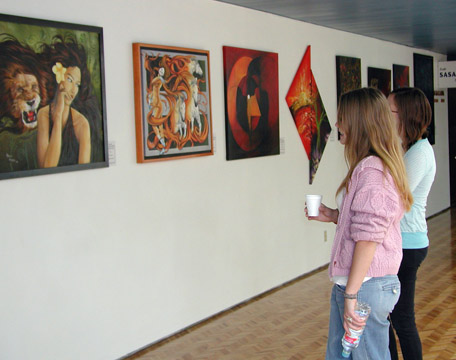 Seven local artists are displaying over 30 thought-provoking paintings in El Batán’s library reading room and outside of the Sasakawa room. This “Expressions” exhibition will run from 22 May until 22 June and is a visual reminder of the library’s recent and evolving revitalization. In addition to improved access to scientific journals and databases and an influx of new materials, the library now provides an internet corner and a cozy room for meetings or language classes. Throughout the year, interactive events such as exhibitions and artist presentations will provide stimulating social opportunities for headquarters staff.
Seven local artists are displaying over 30 thought-provoking paintings in El Batán’s library reading room and outside of the Sasakawa room. This “Expressions” exhibition will run from 22 May until 22 June and is a visual reminder of the library’s recent and evolving revitalization. In addition to improved access to scientific journals and databases and an influx of new materials, the library now provides an internet corner and a cozy room for meetings or language classes. Throughout the year, interactive events such as exhibitions and artist presentations will provide stimulating social opportunities for headquarters staff.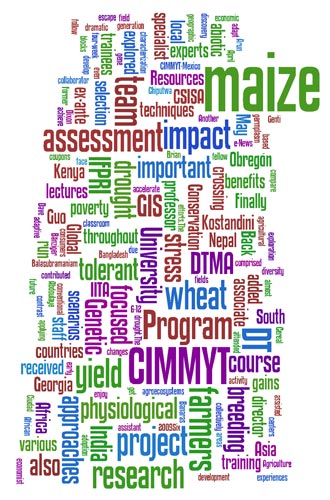 Sharing information about CIMMYT’s work is essential for promotion, public awareness, and internal communication. The CIMMYT Informa and, more recently, the Intranet, have been the main internal communication vehicles for years. But in October 2008 Corporate Communications implemented a CIMMYT blog to share selected information from the Informa with a broader readership, enable fast communication of brief informal news, share communication responsibilities CIMMYT-wide, and make it possible for readers to give feedback. CIMMYTs Blog (blog.cimmyt.org) has registered over 2,500 visits from 114 countries with more than 6,000 page views, and the trend is on an upswing. A Spanish version was launched last week (blogesp.cimmyt.org). We invite CIMMYT staff to contribute directly; contact Petr Kosina or Laura Yates for a simple explanation of how it works. Postings can be made from anywhere, at anytime, and with the greatest of ease!
Sharing information about CIMMYT’s work is essential for promotion, public awareness, and internal communication. The CIMMYT Informa and, more recently, the Intranet, have been the main internal communication vehicles for years. But in October 2008 Corporate Communications implemented a CIMMYT blog to share selected information from the Informa with a broader readership, enable fast communication of brief informal news, share communication responsibilities CIMMYT-wide, and make it possible for readers to give feedback. CIMMYTs Blog (blog.cimmyt.org) has registered over 2,500 visits from 114 countries with more than 6,000 page views, and the trend is on an upswing. A Spanish version was launched last week (blogesp.cimmyt.org). We invite CIMMYT staff to contribute directly; contact Petr Kosina or Laura Yates for a simple explanation of how it works. Postings can be made from anywhere, at anytime, and with the greatest of ease!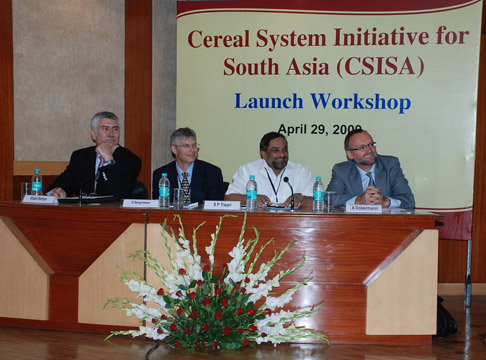 The Cereal Systems Initiative for South Asia (CSISA) was formally initiated 29 April 2009 in Delhi, India. This large project, which is jointly funded by the Bill & Melinda Gates Foundation and USAID, brings together public- and private-sector organizations and international agricultural research centers (IRRI, CIMMYT, IFPRI, and ILRI) to reduce hunger and increase food and income security for resource-poor farm families in South Asia. The launch of this project comes at a critical time for South Asia, home to 40% of the world’s poor with nearly half a billion people subsisting on less than USD 1 a day. The project’s targeted countries of Bangladesh, India, Nepal, and Pakistan are struggling to boost grain supplies in the wake of growing demand and strained natural resources. CSISA aims to increase the cereal crop yields of at least 6 million farmers in these regions by at least 0.5 t/ha. With this huge task ahead, time is precious and so many parallel planning activities and interviews for local staff positions were conducted alongside the launch to speed the project’s progress.
The Cereal Systems Initiative for South Asia (CSISA) was formally initiated 29 April 2009 in Delhi, India. This large project, which is jointly funded by the Bill & Melinda Gates Foundation and USAID, brings together public- and private-sector organizations and international agricultural research centers (IRRI, CIMMYT, IFPRI, and ILRI) to reduce hunger and increase food and income security for resource-poor farm families in South Asia. The launch of this project comes at a critical time for South Asia, home to 40% of the world’s poor with nearly half a billion people subsisting on less than USD 1 a day. The project’s targeted countries of Bangladesh, India, Nepal, and Pakistan are struggling to boost grain supplies in the wake of growing demand and strained natural resources. CSISA aims to increase the cereal crop yields of at least 6 million farmers in these regions by at least 0.5 t/ha. With this huge task ahead, time is precious and so many parallel planning activities and interviews for local staff positions were conducted alongside the launch to speed the project’s progress.